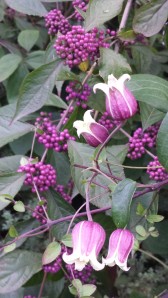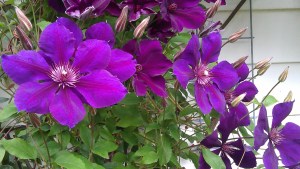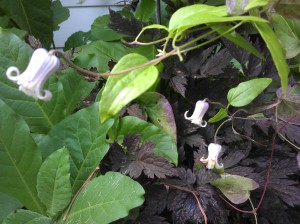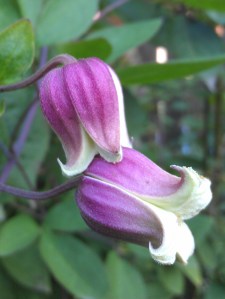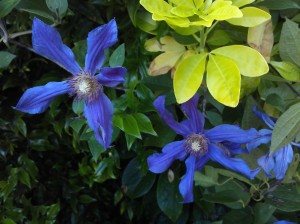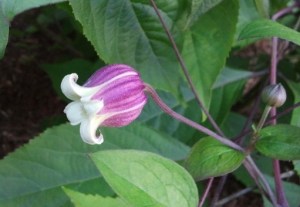
Clematis ‘Buckland Beauty’–beautiful bell flowers inherited from Clematis texensis.
Gardeners who have a nodding acquaintance with clematis are often only aware of the big beautiful heart-stopping, jaw-dropping blossoms of late spring. As one becomes more and more enamored with clematis and delves deeper into the genus, the dainty beauty and wide variety of the bell-shaped flowers are the ones that captivate.
The southeastern US is a breeding ground for many bell-flowered clematis species, which have long been widely used by hybridizers to create lovely new plants. Clematis ‘Buckland Beauty’ above, for example, is the result of a cross between Clematis texensis (a red bell-flowered species from Texas) and one of the other species.
The Texensis Clan
In my last post, I described Clematis texensis and some of its progeny. The species, which grows in Texas, is variable. The flowers tend to have a downward-facing bell shape, usually with recurved tips, sometimes lined with white or yellow. The inside of the tepals can be various shades of red, yellow, or white.

A lovely red Clematis texensis with white accents

A Clematis texensis seedling with reddish-purple outer tepals, white on edges and the underside

Here’s another, a bit pinker with a shorter flower.
Hybridizers discovered the wonderful red of Clematis texensis (also called the Scarlet Clematis) in the late 1800s, and still today exciting new hybrids come onto the market. Crossing Clematis texensis with other types of clematis has resulted in an astonishing variety of new and beautiful plants, such as flatter blossoms of Clematis ‘Ville de Lyon’ and Clematis ‘Catherine Clanwilliam’ showcased in my last post. Of course, many of the progeny have bell-shaped blossoms, like the aforementioned Clematis ‘Buckland Beauty’ and the following lovely offspring of this interesting species.

Clematis Sonnette climbing through a variegated Azara.

Clematis ‘Duchess of Albany’, hybridized using C. texensis 125 years ago!

The beautiful Clematis ‘Princess Diana’
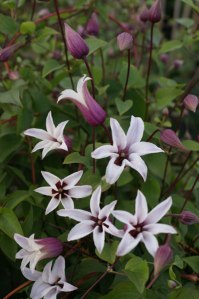
Clematis Princess Kate ‘Zoprika’, one of the newest texensis hybrids coming from J. van Zoest Nursery in The Netherlands. Photo from J. van Zoest Nursery.
The Crispas
Clematis crispa is another American species, native in the southeastern US. This sweet small bell flower often has tepals that curl strongly back on themselves. It comes in many soft colors–white, light blue, mauve, pink. The crowning glory for this clematis is its beautiful light fragrance.

One form of Clematis crispa

Clematis ‘Betty Corning’, discovered growing in a garden in Albany, is clearly a Clematis crispa seedling, especially given its delightful fragrance.

Clematis ‘Princess Red’ certainly looks to be a Clematis crispa hybrid, but the color suggests that Clematis texensis might be the other parent!
The Viornas
Clematis viorna, like C. crispa and C. texensis, is one of over 20 species that are native to the southeastern US and Texas, which are all grouped together in the viorna section of the genus clematis. Clematis viorna is just one of the many clematis in the viorna section. It has flowers in the shape of small bells or urns that come in colors like red, pink, reddish brown, and purple. Many plants sold as the species may actually be hybrids of Clematis viorna and another clematis in the larger viorna clan.
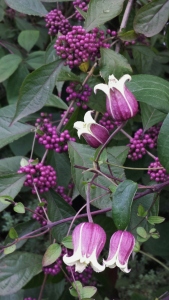
One of my two Clematis viorna. This one pairs beautifully with Beauty Berry!

A different Clematis viorna looking adorable on my fence
Japanese Hybrids
Many interesting clematis with bell-shaped flowers have been coming out of Japan for many years. Joy Creek Nursery is a good source for Japanese clematis. Below are three examples.

The fragrant Clematis Kahori no Kimi–perhaps Clematis crispa is a parent?

Clematis Hakuji–another Clematis crispa descendent?

Clematis Shizuku–looking a little viorna-like?
The best sources I’ve found for bell flowers are Brushwood Nursery and Joy Creek Nursery. So, come on–get one of these dainty-blossomed clematis for your very own!

